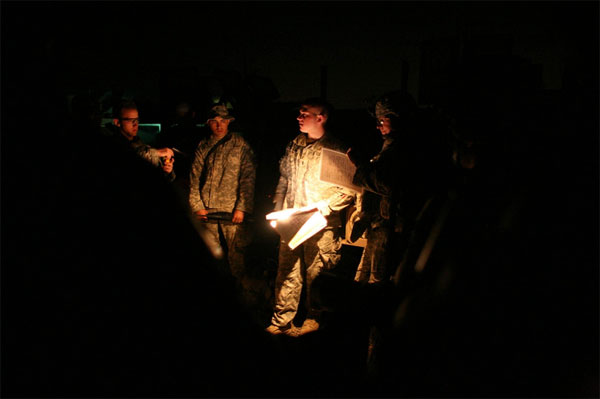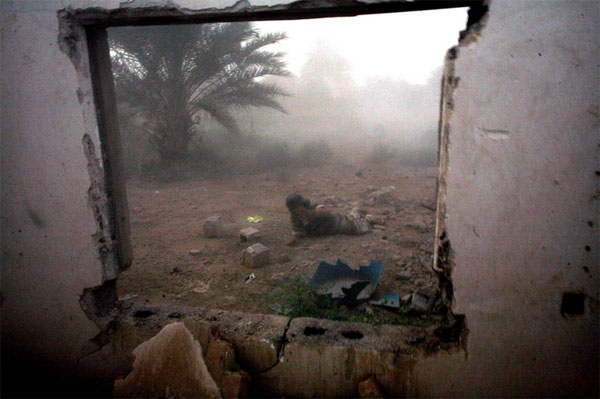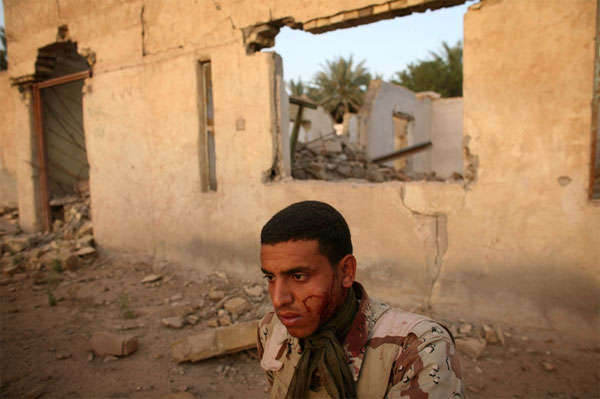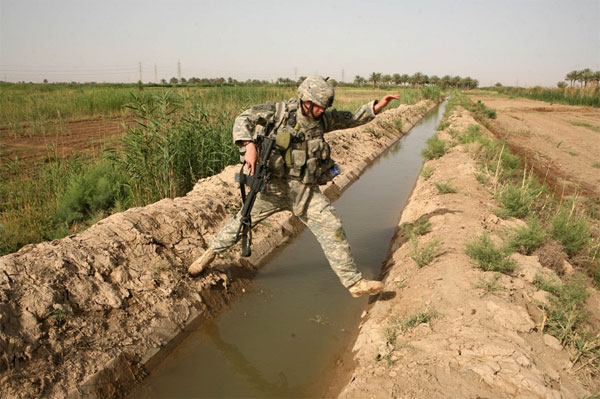 |
→ July 2007 Contents → Feature
|
Death of a Soldier
July 2007
|
 |
|
For several years, I had avoided returning to Iraq. During my last trip, in 2004, I had several close calls: RPGs that sailed just wide, an IED that went off an instant late, mortars that missed by meters. I've covered numerous conflicts, but save for the worst days in Liberia, this violence was on a new level.
But there was more to it than that. There was a character to the war that I particularly loathed – that many photojournalists hated. I began to think of it as "the pushbutton war." It was a uniquely difficult and unsatisfying conflict to cover.
There was often no buildup to the violence and there were few big operations to photograph. And the rebels you wanted to embed with – they wanted to cut your head off. The car bomb scenes and hospitals and morgues – in other conflicts, good sources of photographs – were off-limits. So you were largely restricted to embeds. And then there were the ever more draconian embed restrictions.
But you had little choice, so you signed the embed forms in the Green Zone and you drove around for hours, claustrophobic in an armored vehicle, dripping wet in the 125-degree heat. Then someone pushed a button and there was a flash. You were either killed, or not. And there was nothing for the troops to shoot back at, and little for you to photograph.
Yet I recently bought a book of astonishing images by Henri Huet, the French/Vietnamese photographer who was killed with Larry Burrows in Laos during the Vietnam War. What struck me about Huet, as with Horst Faas, Tim Page, Nick Ut and the rest of the Vietnam legends, was that they did not go to Vietnam for a few weeks or a month. Huet and Burrows and many others went to Vietnam in the early Sixties and stayed for years on end. And I thought, "Where is our commitment to covering the major conflict of our generation?"
So I left the conflicts I'd been covering in Africa – Somalia, Darfur and Chad – and returned to the Baghdad bureau of The New York Times for another tour.

Latafiya, Iraq, May 19, 2007 [Alpha Co. 2-15, Task Force 2-15, 2nd Brigade Combat Team, 10th Mountain Division] – Soldiers hold a pre-dawn briefing to discuss the upcoming mission. Two of the men in this photo were wounded a short time later. The soldier 2nd from the left is medic Sgt. Joshua Delgado, seen treating the wounded in many photos.
I was sleepy and irritable from lack of sleep. There was a briefing around 5 a.m., the soldiers looking at maps and photos by flashlight. Then we put on our flak jackets, climbed into the Humvees and rolled out past the wire.
A kilometer or so away, we met a group of about 50 Iraqi soldiers. Everyone milled about for a while, and then, as it began to get light out, we set off down a dirt road into the countryside. I've spent a lot of time in the cities cooped up in Bradleys and Humvees, driving around for long hours. I was content to be out on open ground.
Iraq is, in my opinion, one of the ugliest countries in the world. It is largely mile upon mile of flat, parched, scrub-covered plains and trash-strewn desert. But here in the farm belt, there was lush green vegetation and groves of palm trees rose around us. The stifling heat had not yet begun, and in the stillness there was a rare beauty to Iraq that I had not seen before.
The stillness was broken only by the muffled footsteps and by the ringing cell phone of an informant we had picked up. He was directing us to homes he claimed to have intelligence on. At the time, I thought nothing of the ringing cell phone. We continued down the dirt road, everyone staring at the ground for signs of an IED or a land mine.
We had not gone far, 150 meters or so. There was a destroyed house by the side of the road and I stepped inside to shoot out through the broken window. As I crossed the threshold, there was a massive, horrific explosion.

Latifiyah, Iraq, May 19, 2007 – A wounded Iraqi soldier seconds after the blast. A combat patrol today ended in tragedy when one U.S. soldier was killed and four wounded (three Americans and this Iraqi Army soldier) following the explosion of a land mine or IED
I had the same fleeting thought I always have at these moments: "Why can't I turn back time, fast-forward past that one bad scene – this one bad scene – that didn't come out the way I wanted it to." But you know there will be no replay and you have to pick up the camera and go out and face it.
There was the possibility of an ongoing grenade or rocket attack, but I heard no small arms. That left an IED or a land mine. And if there was one land mine, there could be others. I decided to chance it – I couldn't stay in the house – and I began to run towards where I'd come from, towards the cloud of dust and explosives.

Latafiya, Iraq, May 19, 2007 [Alpha Co. 2-15, Task Force 2-15, 2nd Brigade Combat Team, 10th Mountain Division] – An Iraqi soldier wounded in a blast that also killed an American soldier. The troops were taking part in the search for three U.S. comrades abducted several days earlier.
The dead soldier had landed partly on top of a badly wounded soldier, his head on the wounded man's legs. It had only been a matter of seconds, but already a medic was at his side, unzipping his medical bag.
I took a few photos as I approached, seeing things but not really processing them completely. I had taken a half-dozen frames when a captain shouted at me not to photograph. As I thought about how to respond, the medic looked up and asked me to help him.
I took the medic's shears and cut away the wounded man's flak jacket and clothes and talked to him, asking him about where he was from. The medic's name was Delgado and the two of us tried to keep the soldier alert and distract him from the pain. He was conscious, but his face was terribly wounded. It was already swelling and covered in blood from shrapnel, and his eyes and ears were caked in dirt. When I cut away his shirt I could see that he had no serious wounds to his torso. And I thought immediately that he would survive, as bad as he looked.
I was surprised at how quiet it was. I heard someone in the distance calling for a helicopter evac, giving GPS coordinates. A soldier nearby, who looked to be about 19, began to curse and swear revenge. Delgado looked at him and said simply, "Not now, this isn't the time," and the soldier quieted down.
I got up and ran to the captain and told him that I had permission to be there and that I was going to do my job. I said they could seize the photos later if they wanted to. He nodded to me. I ran back and knelt by the medic and began to shoot as he checked vital signs and searched for puncture wounds.
Delgado asked me to help him again as he bandaged the wounded man's arms. I was glad for the request and put down the camera. Helping bandage the soldier made me feel like less of a vulture.
Behind me was another wounded soldier; he was on his knees, his eyes closed and blood trickling down his face. I did not know the wounded soldier had been temporarily blinded and lost much of his hearing in the blast.
As he knelt there, pitched slightly forward, he kept asking how his sergeant was. "I'm worried about my sergeant," he said. No one had yet told him the sergeant was dead. I took the wounded man's photo and moved away. I wasn't going to be the one to do it.
The badly wounded man had been put on a litter now and another soldier was bent over him saying, "I love you man, I love you." Many of the soldiers I've met in Iraq are bar brawlers who tell fag jokes. But the soldier kept repeating, "I love you man," and finally the wounded soldier said, "Why are you saying you love me? Stop saying that."
The first soldier seemed hurt, "I can tell you I love you if I want to," he replied.
They had found a body bag by now, and they unzipped it and laid it next to the corpse. The L.T. began to pull some gear off the soldier's flak jacket, then thought better of it, and the four men lifted him, moved forward and gently lowered him into the bag with his helmet and gear still on. They put him down as you would lay down a sleeping baby.
We waited what seemed a long time for the medevac chopper. In reality, it took 30 minutes from the time of the attack. We heard it coming in the distance and a soldier threw out red smoke to mark the LZ [landing zone]. As the chopper came in, the air filled with dirt and debris, and the soldiers huddled around the wounded man to keep his wounds clean.

Latafiya, Iraq, May 19, 2007 [Alpha Co. 2-15, Task Force 2-15, 2nd Brigade Combat Team, 10th Mountain Division] – As the sun rises, a wounded soldier is carried by his comrades to a medevac chopper. He was seriously injured and has been evacuated to Germany. A 22-year-old comrade was killed and three other soldiers were wounded when a land mine or IED detonated as they searched for three missing American soldiers.
I looked back at the dirt road and wondered how they had managed to place a land mine on a traveled pathway and not kill any Iraqi villagers, or even Iraqi soldiers. An L.T. later said they didn't care who they killed, but somehow they had hit exactly whom they wanted to hit. I had seen no wires, yet I wondered if the explosion had been command detonated.
Beside the Humvees, the soldier who had earlier sworn revenge was now crying, his arms wrapped around another soldier. I shot a frame from the hip, and then as I raised the camera, he moved away. Nearby, the soldiers were handcuffing the informant with the ringing cell phone. They believed he might have helped to set up the attack through the phone calls.
As we lingered on the road, I thought of how lives change here in just an instant (though it is an instant that your foe has been planning for a long time). There is no process, no gradual way into this fight. You're OK, then you're blown apart. And in some way I think that makes it even harder.
And I thought of the dead soldier's family back home and felt somehow guilty that they did not yet know. It was 6:30 a.m. and with the time difference, they were probably still awake, up late watching TV, or getting ready to go to bed. They are going on with their lives, not knowing that already their lives had changed so much – that when they get up in the morning, someone will knock on their door and tell them that their son, or boyfriend or brother died yesterday in Iraq.
The dead soldier was 22 years old. His buddies said he had a girlfriend back home that he was going to propose to on his next leave.
I was shaken by the death, as was Damien Cave, the writer I was with. We agreed we'd had enough for the day, but then changed our minds as a new platoon came in to take the place of the one that had suffered the four casualties. The missing soldiers were still out there and the search would continue.
With the new platoon, we walked back down off the main road, this time staying to the grassy fields and away from the soft sandy areas where the explosive had been planted. The sun was fully up now and it was soon well over 100 degrees. I was carrying about 50 pounds, including my flak jacket. Within minutes, sweat had soaked through my shirt and then it began to seep down past my waist, towards my knees until my pants were wet as well.

Latafiya, Iraq, May 19, 2007 [Bravo Co. 2-15, Task Force 2-15, 2nd Brigade Combat Team, 10th Mountain Division] – After an explosion that killed an American soldier and wounded four coalition troops, the patrol for three missing American soldiers continues, with a U.S. soldier jumping across a canal seen here. The original company, Alpha, was replaced by Bravo Company, to which this soldier belongs. As the patrol continued, a U.S. medic was critically wounded when an Iraqi sniper shot him in the forehead.
With the bomb and the sniper, the coalition forces had taken six casualties in just a few hours. No one had so much as set eyes on an attacker. Overhead we could hear the buzz of a remote-controlled drone, and higher still, the distant sound of F-16s. There is a high-tech/low-tech dichotomy to this war: the U.S. with its limitless supply of multimillion dollar machines; the enemy with old mortar shells or C4 wired to doorbells and camera flashes, and shooting at us with 50-year-old sniper rifles.
Back at the base that night, the editing and censoring process began. The embed regulations had recently been changed to say that no photos of identifiable wounded soldiers could be published without their written permission. Nor of identifiable soldiers killed in action. The explanation was that this rule was in place to protect the soldiers and their families. This seemed patently unworkable. The badly wounded soldier I had photographed earlier was temporarily blinded by the blast and on a plane to Germany. How could he be shown a photo and asked to sign off on it?
[Two of the slightly wounded soldiers returned to their unit the next day. I showed them their photos and they quickly signed releases.]
I asked John Burns, The New York Times' Baghdad bureau chief, a rhetorical question I repeat here. What would our collective photographic history of World War II look like if Robert Capa was forced to chase stretchers down Omaha Beach on D-Day trying to get releases? What would our history of Vietnam be if Tim Page or Don McCullin carried a clipboard as they worked and presented it for signatures at Khe Sanh or Hué?
Here in Iraq, we wanted to show the most dramatic photos, ones that would show the public what the soldiers in Iraq were sacrificing in this war. Yet Damien Cave had earlier been thrown out of an embed after pictures taken by another photographer during a battle in Baghdad were published. Those pictures showed a wounded soldier who later died.
Damien was the writer on the story and had no control over what was published, but he was persona non grata with the military just the same. He was just now beginning to get embed positions again. And as I dealt with the PAOs, I got the distinct impression that The New York Times was not liked or trusted by the military brass.
Despite his vulnerable status, Damien pushed me to show the most dramatic pictures that fell within the guidelines. The editors in New York supported us and encouraged us not to back down. Others on the paper disagreed and counseled caution for fear of further angering the military.
Many photos I immediately rejected as being too bloody. Others were not submitted because they showed the dead soldier. Though he was not identifiable, (and therefore the photo technically complied with the embed rules), I thought these pictures would provoke the wrath of the military.
Then there was a second level; less graphic, but still somewhat disturbing. In several photos, the soldier's face was visible, but due to the swelling and blood, unrecognizable to me. We began to get into theoretical questions as to whether a family member could recognize him and realized that the rules were dependent on judgment calls. As we pondered which photos to use, Damien and I had numerous conversations with PAOs at different levels.
A top-level public affairs officer ratcheted the rules tighter still in a phone conversation. She told us that even if the wounded man's face was not identifiable, we could not publish a photo if the soldier's unit was identifiable, or if other soldier's faces in the photo were visible. Her reasoning was that families could figure out the identity of the wounded man by seeing his unit or by seeing other soldiers that they recognized. Since every infantryman has clearly visible division badges on his shoulders, this effectively ruled out nearly every photo I had taken.
General Raymond Odierno, Commanding General of the Multi-National corps in Baghdad, was known to be particularly hostile to images of injured soldiers being shown. His son had been badly wounded in Iraq.
I decided to disregard the PAO's phone instructions and chose photos I believed were within the written guidelines, picking ones that showed the badly wounded soldier with his face bandaged, or with an arm obstructing his head.
I tried repeatedly to show the photos to several high-level PAOs, telling them I was not seeking their approval, but simply wanted to show them what we might publish so that there would be no surprises. They all refused to see the photos. Each told me in no uncertain terms that, from my description, they found the photos offensive and expected a backlash from military families. They in no way wanted to be seen as signing off on the pictures.
In the end, The New York Times editors took the embed rules as they were written. They published numerous photos of the wounded but chose them carefully to comply with the regulations. The two most graphic images, the ones the PAOs found most offensive, were not used.
Contrary to what we had been led to expect by the Army, the soldiers from the unit that suffered the casualties came to thank us on the day of publication. One wounded soldier asked for copies of the pictures. They said we had shown the American people what they go through in Iraq, the sacrifices they make.
A few days later, the grandfather of the most seriously wounded soldier – the one who had been evacuated to Germany – sent Damien and me an e-mail. He too wanted copies of the newspaper. He said the photos were essential to the healing process of his grandson.
Later in the week, the unit asked us to photograph the memorial service for the dead soldier. In the early years of the war, the press was invited to these memorials. Now the rules had changed; the Army brass refused us permission to photograph the memorial. They claimed, once again, that they were protecting the families.
© Michael Kamber
|
|
Back to July 2007 Contents
|
|